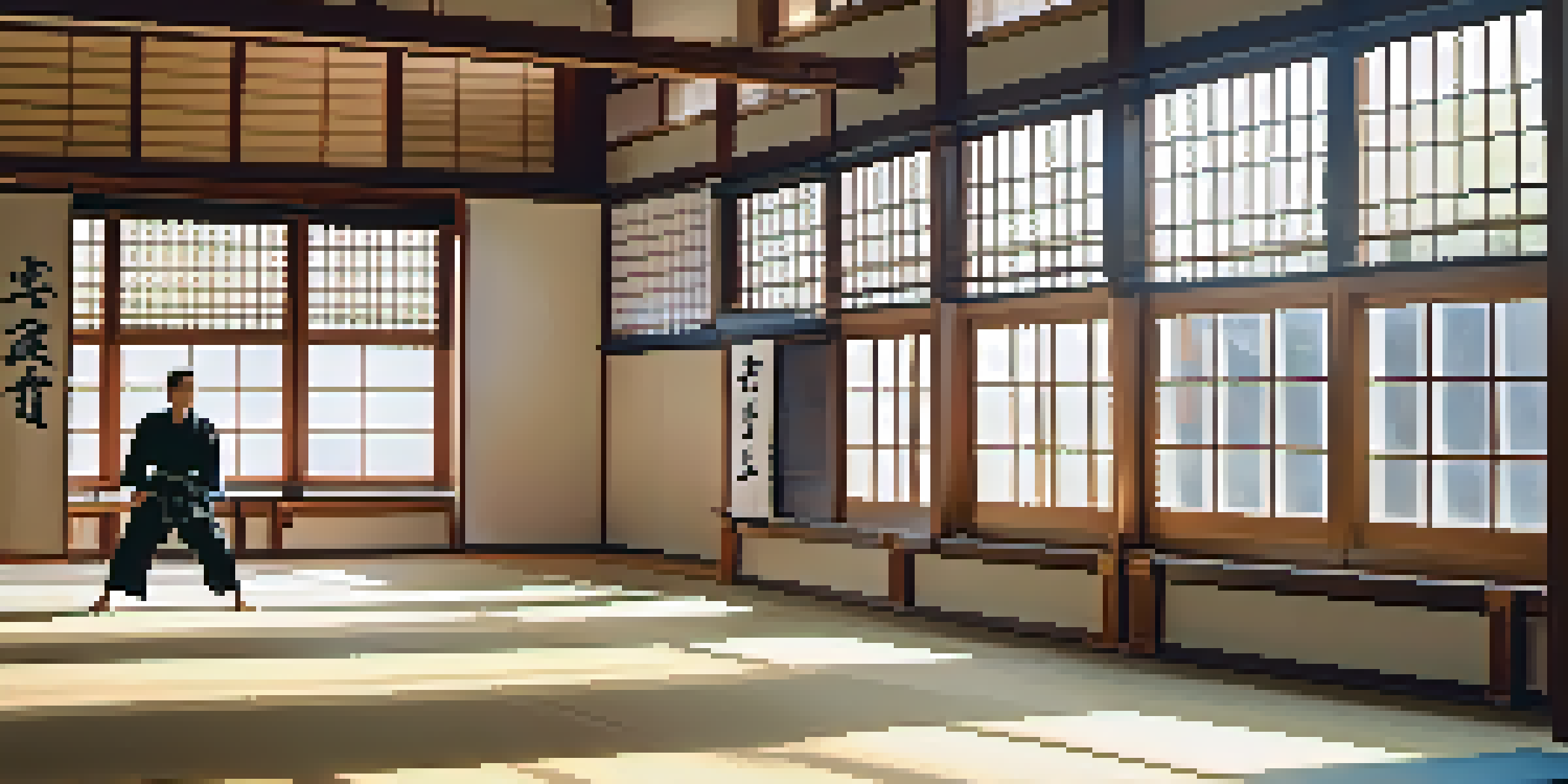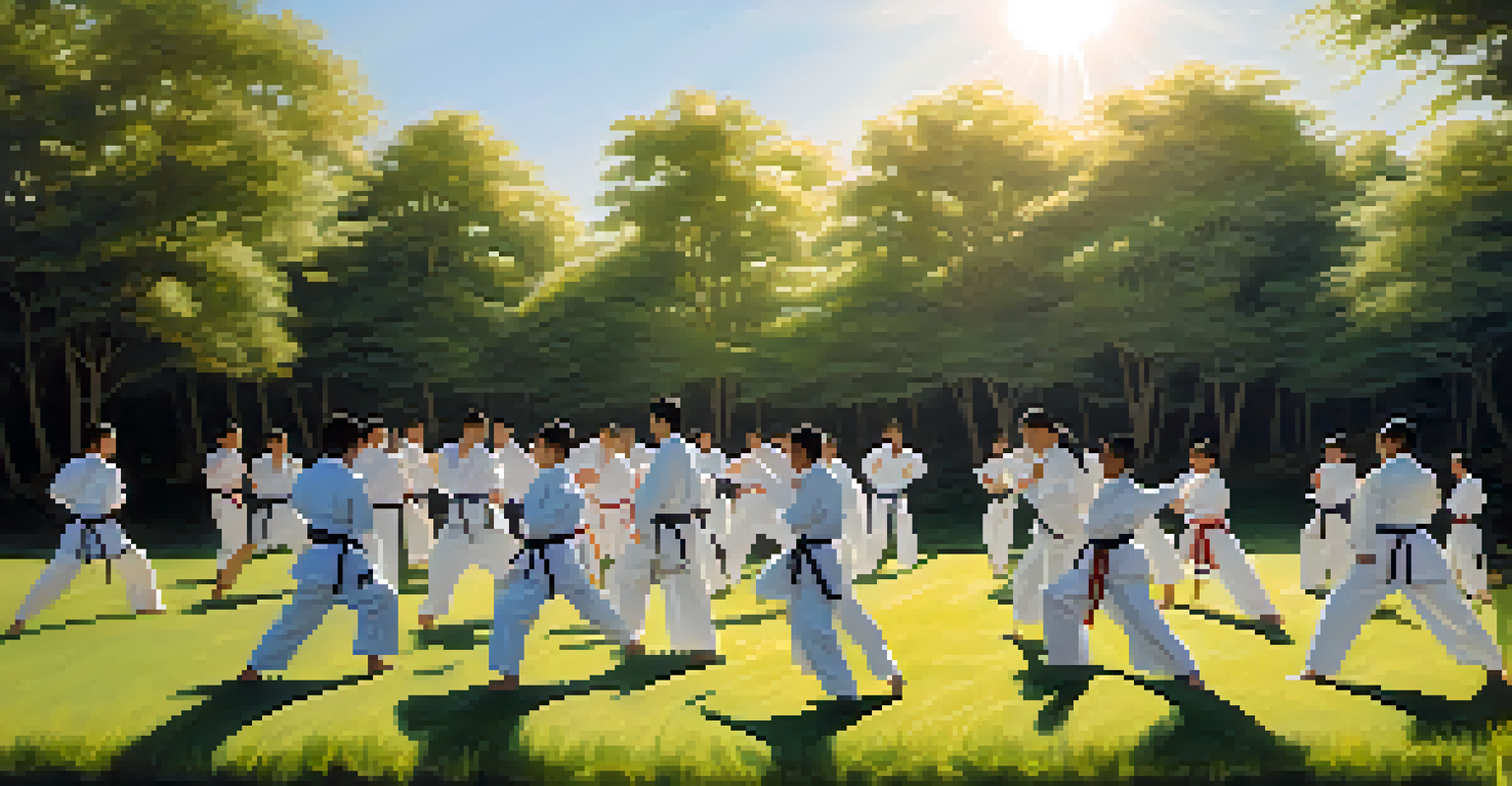The Role of Environment in Martial Arts Performance

Understanding the Importance of Environment in Training
The environment where martial artists train plays a crucial role in their development. Factors like space, equipment, and even weather can influence how effectively one can practice techniques. For instance, training in a spacious, well-ventilated dojo allows for more dynamic movements and better focus. Conversely, cramped or distracting environments can hinder progress and motivation.
Success is where preparation and opportunity meet.
Additionally, the ambiance of the training space can significantly affect an athlete's mindset. A bright, well-decorated studio may inspire creativity and enthusiasm, while a dull, poorly lit area might lead to a lack of energy. This psychological aspect is often overlooked but is vital for achieving peak performance.
Finally, having access to the right facilities, such as mats for grappling or heavy bags for striking, can enhance skill development. A suitable environment not only supports physical training but also fosters a positive mental space, which is essential for martial arts success.
Influence of Outdoor vs. Indoor Environments
Training indoors offers controlled conditions, which can be beneficial for focused skill development. However, outdoor environments introduce variables like wind, terrain, and temperature, which can challenge martial artists. For example, practicing kicks on grass versus a hardwood floor can feel entirely different, forcing athletes to adapt their techniques.

Moreover, outdoor training can enhance resilience and mental toughness. Facing the elements, whether it's a brisk wind or uneven ground, teaches fighters to remain composed under pressure. This adaptability can translate to better performance in competitions, where unforeseen challenges often arise.
Training Environment Shapes Performance
The physical and psychological aspects of a training environment significantly influence martial artists' development and success.
Ultimately, both indoor and outdoor training environments have their merits. A balanced approach that incorporates both settings allows martial artists to become versatile and well-rounded fighters, ready to tackle any situation.
Cultural Context and Its Role in Martial Arts
The cultural backdrop of a martial art can significantly shape the training environment. For example, traditional dojos in Japan often emphasize discipline and respect, creating a unique atmosphere for learning. This cultural context can influence not only the physical training but also the values and philosophy imparted to practitioners.
The environment where you train can shape your mindset and performance as much as your physical skills.
In contrast, modern martial arts schools might adopt a more casual and flexible approach, reflecting contemporary values. This can lead to a different kind of camaraderie and motivation among students, impacting their performance. Understanding these cultural nuances is essential to grasp how they affect the martial arts journey.
Moreover, the environment, shaped by culture, also sets expectations for behavior and performance. Athletes immersed in a culture that values hard work and humility may push themselves harder, leading to better results over time.
The Role of Supportive Training Environments
A supportive training environment is crucial for martial artists at any level. This includes having knowledgeable instructors who can provide guidance and constructive feedback. A positive and encouraging atmosphere fosters growth and helps individuals overcome challenges, ultimately enhancing performance.
Furthermore, the camaraderie among training partners can make a significant difference. When athletes feel supported by their peers, they are more likely to take risks, push their limits, and improve their skills. This sense of community can transform a challenging practice into a motivating experience.
Adaptability Enhances Competition Skills
Training in diverse environments prepares martial artists to effectively handle the unpredictable challenges they face in competitions.
In essence, a nurturing environment, characterized by encouragement and collaboration, can lead to greater achievements. Such spaces are often the breeding grounds for champions, where individuals learn not only from their instructors but also from each other.
Environmental Factors Affecting Physical Performance
Various environmental factors, such as temperature and humidity, can directly impact physical performance in martial arts. For instance, training in hot and humid conditions can lead to quicker fatigue and dehydration. Understanding these factors helps athletes prepare better for competitions and training sessions.
Moreover, altitude can also play a role, as training at higher elevations can enhance lung capacity and endurance. However, this advantage requires a period of adaptation to avoid performance dips. Athletes must be mindful of their training environments to maximize their potential and stay injury-free.
Ultimately, recognizing how these environmental factors interact with physical performance allows martial artists to tailor their training accordingly. This proactive approach can lead to improved results and greater resilience.
Psychological Impact of Training Environments
The psychological impact of an athlete's training environment should not be underestimated. A welcoming and positive atmosphere can boost confidence and motivation, essential components for success in martial arts. When individuals feel good about their surroundings, they are more likely to engage fully in their training.
On the flip side, a negative or intimidating environment can lead to anxiety and self-doubt. This affects not only performance but also the overall enjoyment of martial arts. Creating a supportive space where athletes can thrive psychologically is crucial for long-term success.
Cultural Context Influences Training
The cultural background of a martial art shapes the training atmosphere, impacting values, expectations, and overall performance.
Therefore, martial arts schools and instructors should prioritize fostering a positive environment. This can involve team-building activities, open communication, and celebrating individual progress to enhance mental well-being and performance.
Adapting to Different Environments in Competitions
Competitions often take place in unfamiliar environments, requiring martial artists to adapt quickly. This can include different surfaces, lighting, and even the presence of spectators. Being able to adjust to these variables can make the difference between victory and defeat.
Preparation for such environments is key. Athletes should practice in various settings to build adaptability and confidence. For instance, training on different surfaces, like grass or sand, can help fighters become accustomed to how their techniques might change in competition.

Ultimately, the ability to thrive in diverse environments is a hallmark of a well-rounded martial artist. Those who embrace the challenges presented by varied settings often come out on top, showcasing their resilience and versatility.
Conclusion: Embracing the Environment for Success
In conclusion, the environment plays an integral role in martial arts performance, influencing everything from physical abilities to mental resilience. By understanding and embracing the various aspects of their training spaces, athletes can unlock their full potential. Whether it's the cultural context, physical conditions, or psychological atmosphere, each element contributes to a martial artist's journey.
Martial artists should actively seek out diverse training environments to prepare for the unpredictable nature of competitions. By doing so, they enhance their adaptability and overall performance. The journey in martial arts is not just about mastering techniques but also about navigating the spaces in which they train.
Ultimately, a mindful approach to the environment can empower martial artists to reach new heights. As they cultivate a deeper awareness of their surroundings, they can transform challenges into opportunities for growth and success.